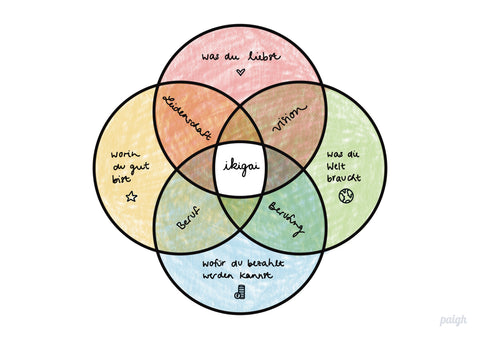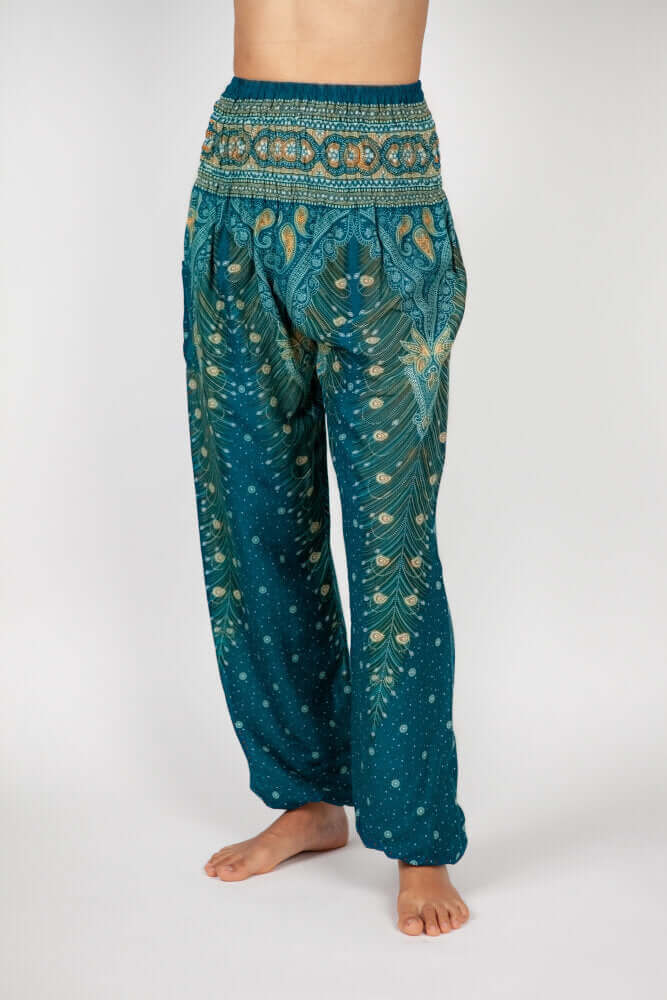
Inhaltsverzeichnis
Die Ikigai-Methode: Auf dem Weg zu einem erfüllteren Leben (ÜBUNG)
Was unserem Leben einen Sinn gibt, ist für jeden Menschen verschieden. Die Ikigai-Methode ist ein Konzept, das uns dabei helfen soll, diesen ganz individuellen Lebenssinn ausfindig zu machen. Das geschieht vor allem durch eine bestimmte und einfache Übung. Alles, was du brauchst, sind Zeit, ein Stift und Papier.
“Ikigai” ist japanisch und steht für “Lebenssinn” oder “das Gefühl, etwas zu haben, für das es sich lohnt, morgens aufzustehen”, und kann damit auch als Lebensphilosophie verstanden werden. Was ursprünglich damit gemeint war und wie Ikigai heute vor allem im westlichen Raum interpretiert wird, kannst du detaillierter hier nachlesen. Im Zentrum der Ikigai-Methode steht dabei ein Diagramm aus vier Kreisen, die sich schneiden. Der Schnittpunkt aller vier Bereiche stellt das Ikigai dar – den “Lebenssinn”. Jeder Kreis repräsentiert eine eigene Rubrik: Was wir gerne tun, was wir gut können, wofür wir bezahlt werden können und was die Welt braucht.

Das Diagramm lässt sich wunderbar in eine Reflektions-Übung umwandeln, um die es heute gehen soll. Sie kann dir dabei helfen, dem Sinn deines Lebens näher zu kommen.
Die Ikigai-Methode: Probiere es selbst aus
Vorab sei gesagt: Vielleicht findest du dein Ikigai heute mit dieser Übung, vielleicht aber auch nicht. Beides ist völlig in Ordnung, denn der Sinn dieser Übung besteht vor allem darin, anzufangen und sich selbst zu reflektieren.
Für die Übung hast du idealerweise um die 30 Minuten Zeit und einen Zettel und Stift bereitliegen. Versuche, über die Dinge, die du gleich aufschreibst, nicht zu sehr nachzudenken. Schreibe vor allem das auf, was dir zuerst in den Kopf kommt.
Schritt 1: Vorbereitung
Ziehe eine horizontale und eine vertikale Linie in der Mitte deines Blatt Papiers, sodass du vier gleich große Abschnitte erhältst. Diese vier Bereiche repräsentieren die vier Kreise aus dem Diagramm. Beginne nun im linken oberen Abschnitt und schreibe die Frage “1. Was mache ich gerne?” hinein. Gehe dann weiter entgegen des Uhrzeigersinns und fülle die drei anderen Bereiche mit den Fragen “2. Worin bin ich gut?”, “3. Wofür kann ich bezahlt werden?” und “4. Was braucht die Welt?”

Schritt 2: Die Bereiche mit Inhalt füllen
Nun geht es darum, die Fragen zu beantworten. Gehe die Bereiche einzeln an und nehme die idealerweise 3-5 Minuten pro Abschnitt Zeit.
Wir wollen mit der einfachsten Frage anfangen und arbeiten uns dann langsam vor:
1. Was mache ich gerne?
Folgende Fragen können die bei der Beantwortung dieser Frage helfen:
Beispiel-Antworten:
- tiefe Gespräche führen
- spannende Geschichten / Bücher lesen
- schreiben / Tagebuch führen
- kochen
2. Worin bin ich gut?
Folgende Fragen können die bei der Beantwortung dieser Frage helfen:
Beispiel-Antworten:
- Buchführung
- singen
- anderen Menschen zuhören
- Geschichten und Aufsätze schreiben
3. Wofür kann ich bezahlt werden?
Folgende Fragen können die bei der Beantwortung dieser Frage helfen:
Beispiel-Antworten:
- Marketing
- Blogs schreiben
- Buchführung
- Gesangs-Auftritte auf Hochzeiten
4. Was braucht die Welt?
Diese Frage ist für die meisten die Schwierigste. Daher wollen wir uns in kleinen Schritten an die Beantwortung der Frage herantasten. Frage dich nicht, was “die Welt” braucht, sondern eher, was “deine Welt” braucht: Die Gesellschaft, in der du lebst; dein direktes Umfeld. Die Realität, in der du dich aktuell wieder findest.
Beispiel-Antworten:
- Die Menschen brauchen mehr Spaß und weniger Stress
- mehr miteinander, weniger gegeneinander
- Impulse & Geschichten, die die Menschen inspirieren und sie zum umdenken bewegen
Schritt 3: Dein Ikigai finden
Schaue dir alle Bereiche nochmal an und füge eventuell noch Dinge hinzu, die du ergänzen möchtest.
Kommen wir nun zum spannenden Teil: Deinem Ikigai. Suche aus den vier Bereichen das aus, was sich überschneidet bzw. was immer wieder auftaucht. Dafür kann es sein, dass du ein bisschen kreativ werden musst bzw. überlegst, wie sich verschiedene Dinge miteinander kombinieren lassen. Einige konkrete Aktivitäten oder Fähigkeiten muss man abstrahiert betrachten, um eine Schnittmenge der Bereiche zu finden. So kann ein “ich kann gut malen und mache das auch gerne” und ein “ich wurde bisher bezahlt für das Schreiben von Songtexten” und ein “die Menschen in meinem Umfeld brauchen etwas, das sie glücklich macht / aus dem Alltag entfliehen lässt” zusammengefasst werden zu “Kreativität & Expression”.
In unserem Beispiel wäre die Schnittmenge so etwas wie “aussagekräftige / inspirierende Geschichten schreiben”. – Super, dann sind wir ja jetzt fertig, oder?
Ikigai ist ein Prozess
So einfach ist es nur leider oft nicht. Nicht jede:r von uns findet auf Anhieb das persönliche Ikigai. Manche Menschen brauchen Tage, Monate oder sogar Jahre. Manche Menschen werden sehen, dass sich die Inhalte der vier Kreise bzw. Bereiche je nach Lebensabschnitt oder -phase ändern. All das ist okay.
Das ursprüngliche “Versprechen”, dass man mit dem Ikigai-Diagramm zwangsweise den eigenen Lebenssinn findet, wird also nicht immer erfüllt bzw. eingehalten. Wenn wir das aber nicht als den Anspruch der Übung sehen, sondern sie vielmehr als Chance verstehen, uns selbst besser kennenzulernen und uns in eine Richtung zu navigieren, die unserer Vorstellung eines erfüllten Lebens entspricht, dann kann uns Ikigai viel bringen.
Vielleicht hilft es dir ja schon, dass du dir einfach mal verstärkt Gedanken um diese Bereiche gemacht hast und findest Ansatzpunkte für Dinge, die du in deinem Leben verändern kannst. Das eigene Ikigai zu finden, ist ein ständiger Prozess. Nimm dir Zeit. Stelle dir selbst immer wieder schwierige und herausfordernde Fragen und beantworte sie ehrlich. Reflektiere dich und dein Umfeld regelmäßig. Sei offen dafür, neue Dinge auszuprobieren und aus deiner Komfortzone herauszutreten – Denn bevor man etwas probiert hat, kann man ja gar nicht wissen, ob man Spaß daran hat. Der “Sinn deines Lebens” ist oftmals nicht eine Sache, die für immer gleich bleibt. Traue dich, in verschiedene Richtungen zu denken und diese auszutesten.
Wenn du noch mehr über Themen wie Achtsamkeit & Spiritualität, Nachhaltigkeit, Familie und Schwangerschaft oder gesunde Ernährung erfahren möchtest, schaue dir hier spannende Blog-Artikel dazu an.

Photo by Tarun Savvy on Unsplash



























Leave a comment
This site is protected by hCaptcha and the hCaptcha Privacy Policy and Terms of Service apply.